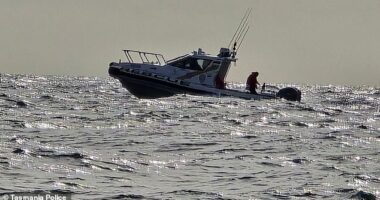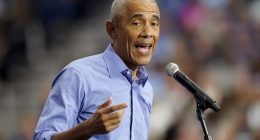Thousands have already fled their homes as Tropical Cyclone Alfred bears down on Australia’s east coast.
The cyclone intensified to a category two system as it changed course and headed towards the south-east Queensland coast.
Last recorded 510km east of Brisbane late Tuesday, Tropical Cyclone Alfred is set to make landfall north of the city either late Thursday or early Friday, bringing destructive winds of up to 130km/h, torrential rain, dangerous surf conditions and major flooding.
Authorities have urged millions in two states between Noosa Heads on Queensland’s Sunshine Coast and Ballina in northern NSW to prepare to evacuate or hunker down.
Voluntary evacuations began on Stradbroke Island on Tuesday as police door-knocked hundreds of homes in low lying areas between the Gold Coast and Sunshine coasts.
South-east Queensland is hours away from coming to an abrupt standstill with schools, university campuses, Gold Coast theme parks, offices and public transport systems all set to shut down on Thursday.
The Brisbane CBD will become a ghost town for the first time since Covid-19 lockdowns with residents ordered to work from home.
Almost 20,000 homes in the Brisbane Council catchment area will be flooded if Alfred continues on its projected path, according to the latest modelling.

Preparations continue as Tropical Cyclone Alfred changes path to head toward Queensland on Tuesday afternoon. Pictured are sandbags laid on Queensland’s Sunshine Coast

The category two cyclone was last recorded 510km east of Brisbane at 10.45pm on Tuesday

Modelling shows regions of Brisbane which could be inundated in the next few days (in blue)
The suburbs of Brighton, Windsor, Ashgrove, Morningside, Rocklea, Coopers Plains, Carina, Sandgate, Hemmant, Lota, Tingalpa, Indooroopilly, Albion, Bardon and Wynnum West are most at risk.
Brisbane Lord Mayor Adrian Schrinner urged residents in these areas to evacuate.
‘These 20,000 properties could experience anything from minor inundation in their yards to significant flooding inside homes,’ he said.
‘The Bureau of Meteorology is expecting peak storm surges to occur from Thursday onwards.
Communities to the north in Moreton Bay and the Sunshine Coast similarly were warned to store water as authorities fear power outages could halt supply.
Gold Coast Council warned up to 6,000 homes are at risk of flooding.
Queensland Rail trains will stop running when wind speeds reach a damaging 90km/h, as will the 79m tall Gateway Bridge over the Brisbane River.
Sports and entertainment events have been cancelled, postponed and relocated for the week.

The cyclone has already drummed up huge swells, authorities warn it will cause ‘destructive’ rainfall, gusts of up to 155km/h and could cause widespread flooding

Residents have been stop urge to stop ‘panic buying’. Pictured are empty shelves at Woolworths on Bribie Island on Tuesday

The eye of the cyclone is expected to make landfall in the Brisbane region of South East Queensland
Schools are expected to remain open on Wednesday but the rest of the week remains unclear.
US punk rock band Green Day scrapped the final gig of their Australian tour at Gold Coast’s Robina Stadium on Wednesday night.
The AFL also announced that it would be cancel two opening round fixtures.
The Brisbane Lions were set to unfurl their premiership flag against Geelong on Thursday night at the Gabba, while the Gold Coast Suns were due to face Essendon at the People First Stadium on Friday.
Friday night’s NRL clash between the Dolphins and South Sydney Rabbitohs has been shifted from Brisbane to CommBank Stadium in Sydney.
The ‘cyclone watch’ was upgraded to a ‘warning’ on Tuesday afternoon.
The warning zone now stretches from Double Island Point on Queensland’s Sunshine Coast to Grafton in northern NSW.
Prime Minister Anthony Albanese was set to fly to Brisbane on Tuesday night, with the federal disaster response plan activated and a crisis co-ordination team to be deployed as the region braces for impact.
‘We are prepared, we are asking Queenslanders to do the same,’ Premier David Crisafulli said.
‘It is a really rare event for south-east Queensland, but it is serious, and it is happening, and we want Queenslanders to be prepared.
‘There is still an element of the population that hasn’t yet fully understood the magnitude of this system … but one thing I know about Queenslanders is they handle disasters better than anywhere else and we’ve proven that time and time again.’
‘And I know that people in the south-east may not have experienced a cyclone before but they’ve been tested with floods and they’ve come through with flying colours every time.’
South of the border, northern NSW communities have also already begun sandbagging efforts ahead of the intense forecast rainfall.
NSW Premier Chris Minns said SES crews and 40 flood rescue teams were on standby in key regions in the state’s far north.
‘Even with all of those resources … we still rely on the public to act early, be prepared to listen to information so that we can limit the amount of exposure to people potentially losing their lives,’ he said.

Experts warn storm tides will be destructively powerful and could cause widespread coastal erosion over the week. Pictured is Byron Bay in far northern NSW on Tuesday

Residents of a number of Brisbane suburbs have been urged to take action and consider leaving their homes amid fears the cyclone could bring disastrous flooding

Queensland Premier David Crisafulli said ‘one thing I know about Queenslanders is they handle disasters better than anywhere else’. Pictured is a Bribie Island resident sandbagging his home

Bribie Island residents collected their own sandbags on Tuesday in preparations for Cyclone Alfred
Premier Minns urged motorists to avoid driving through floodwaters as rains intensify.
‘(Driving through floodwater is) the singly best way of losing your life. You’re endangering yourself, whoever else is in your car and a volunteer from the SES who has to put their own life in danger to save you,’ he said.
A series of weather and hazard warnings from the Bureau of Meteorology were updated on Tuesday night.
Gales with damaging gusts up to 120km/h are expected to develop along south-eastern Queensland and north-eastern NSW coasts on Wednesday.
‘Destructive wind gusts’ of up to 155km/h may develop about the exposed coastal and island locations near to– and south of– the path of Cyclone Alfred late on Thursday.
A dangerous storm tide and abnormally high tides are ‘likely to continue causing minor flooding’ in low-lying coastal areas between Sandy Cape and Grafton, with damaging surf conditions reaching further south through to Friday.









